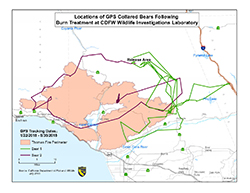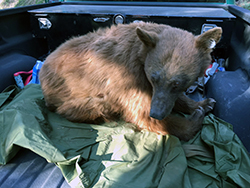
This CDFW map shows the routes
and distances traveled by both bears
since being re-released in January.

The older bear, safely on her way
back to the wilderness after being
tranquilized in Montecito by a wildlife
officer on April 2. (CDFW photo)
We have an update on the two black bears that were burned in the Thomas Fire in late December/early January! Both bears were suffering from extensive burns to their paws when they were brought to CDFW’s Wildlife Investigations Lab in northern California. Under the care of CDFW Senior Wildlife Veterinarian Dr. Deana Clifford and Dr. Jamie Peyton of the UC Davis Veterinary Medical Teaching Hospital, the bears were given an unusual experimental treatment involving the use of sterilized tilapia skins as bandages. After the bears were well enough to survive on their own, they were returned to the Los Padres National Forest, as near as possible to where they were originally found. Both have covered many miles and each has been spotted at least once since their release.
The younger bear was seen in an avocado orchard on May 29 by a biological consultant conducting a bird nesting survey. The bear ran away, which is a good sign that she has not become habituated. The consultant was able to get photos and video of the bear, who appears to be in good physical shape.
The older bear, who was pregnant during treatment and at the time of her release in January, came down from the hills and wandered into the town of Montecito on April 2. A local wildlife officer tranquilized her and returned her to suitable habitat, and she’s stayed away from people ever since. Though she was reportedly in good general health, there has been no sign of a cub, so the pregnancy may not have been carried to term or the cub may not have survived.
GPS collars on the bears allow CDFW biologists to track the animals’ movements so they can see where each one has been. Data shows the younger bear usually stays near Fillmore, but has made the 10-mile trek back to her release site in the Sespe Wilderness Area at least three times. She also made a brief trip over to Highway 5, north of Castaic. The older bear spends most of her time in the hills above Ojai. “We are encouraged and so pleased that both bears have survived for eight months now after burn treatment and release – they have walked hundreds of miles on their treated feet by now,” Dr. Clifford said.
CDFW will continue to monitor the movements of both bears via their satellite collars for at least another year. The data will ultimately help scientists build their knowledge of how animals utilize landscapes affected by large fires.
Read the original story of the Tilapia Bears at: https://tinyurl.com/y849mru7
Top photo: The younger of the two bears, as seen in an avocado orchard on May 29. (Photo by Jessica West)